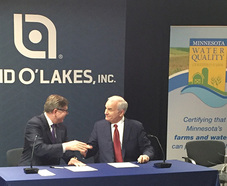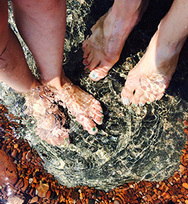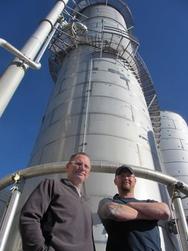
The
Legislative-Citizen Commission on
Minnesota Resources has selected 88
funding proposals for presentations of 181 received for 2017. The commission
expects to have about $50 million available for funding, far less than the $142
million requested in all proposals and $86 million for those making the first
cut.
In
addition, $8.4 million remains available for 2016-17 due to Gov. Mark Dayton’s vetoes
this past session. The commission is giving the seven projects vetoed a chance
to present their proposals for 2017 funding, along with 10 proposals that the
commission recommended for 2016 funding but the Minnesota Legislature cut.
The Legislature also extended
the proposal deadline to June 26 for those seeking more than $750,000, so there
may be additional submissions.
|

The
Minnesota Board of Water and Soil Resources recently awarded nearly $8.2
million in Clean Water Fund grants for targeted conservation work in six
watersheds. The program addresses water
pollution by focusing funding where watershed actions needed for water quality
improvement are known and can be achieved in a four-year period.
This year’s recipients:
- Buffalo Red Watershed District, $2.8
million toward reducing sediment in the Wolverton Creek watershed through best
management practices (BMPs), buffers, and channel stabilization.
- Capitol Region Watershed District,
$1.76 million toward reducing phosphorus in Como Lake and Lake McCarrons
through BMPs and clean streets initiative.
- East Polk Soil and Water Conservation
District (SWCD), $790,240 toward BMPs such as water and sediment control basins
to reduce sediment in the Sand Hill River watershed.
-
Fillmore and Root River SWCDs, $493,233 toward conservation practices to reduce sediment and phosphorus in the
Root River watershed.
- Pelican River Watershed District,
$1.5 million for a wetland restoration project to reduce phosphorus loading in
the Detroit Lake watershed.
- Shell Rock River Watershed District,
$825,610 toward grassed waterways, streambank and wetland restoration to reduce
phosphorus in Pickerel Lake.
|
 A new Minnesota law aims to help communities and industries
save money on long-term wastewater treatment while reducing nutrient pollutants
in lakes and rivers beyond what’s required.
“Cities have expressed a lot of frustration over spending
money on new facilities to comply with new standards, and then having to do
more – at a higher cost – a few years down the road when more standards become
law. We worked with many stakeholders and legislators to develop what’s called
regulatory certainty to provide some assurance for their planning and
investments. We see this as a win-win for our waters and for our cities,” said Rebecca
Flood, assistant commissioner of the Minnesota Pollution Control Agency (MPCA).
Regulatory certainty allows the MPCA to hold the line on
nutrient limits in discharge permits for up 20 years in exchange for
communities and industries agreeing to lower nutrients even more than current
standards. Minnesota has water
quality standards for phosphorus and is working on standards for nitrogen.
Both these nutrients can cause algal blooms harmful to aquatic life and
recreation (photo above). Nitrogen can also be toxic to fish and other aquatic life, as well
as harmful to humans in drinking water.
This approach takes the uncertainty out of planning for
facilities needing to upgrade or build systems to comply with phosphorus
limits. By incorporating nitrogen removal too, they can avoid higher costs to
comply with new standards in 5-10 years.
Regulatory certainty also allows Minnesota to start reducing
nitrogen discharged by wastewater treatment facilities ahead of adopting a
standard. Minnesota finalized a statewide Nutrient
Reduction Strategy in 2014 that calls for a 45% reduction in nutrients in
the Mississippi River Basin by 2040 to protect downstream waters all the way to
the Gulf of Mexico. For phosphorus,
that’s a reduction from 4,600 tons per year to 2,500 tons, and for nitrogen,
91,000 tons a year to 50,000 tons. This strategy includes an interim reduction
goal for the Mississippi River of 20% by 2025.
Instead of waiting for the nitrogen standard to be developed
and mandated, the regulatory certainty approach helps Minnesota take action now
to protect lakes and rivers here as well as downstream.
For
more information, contact Joel Peck, municipal liaison for the MPCA, at
651-757-2202 or joel.peck@state.mn.us.
|

According to recent Minnesota Pollution Control Agency (MPCA) reports, some
lakes and streams in the Sand Hill River watershed are polluted with excess
nutrients including phosphorus, bacteria, sediment that causes cloudiness in
the water, and low dissolved oxygen. In some areas, the pollution is severe
enough to be harmful to aquatic insects and fish.
The Sand Hill River watershed drains 395,249 acres in northwestern
Minnesota. The watershed includes portions of Polk, Norman and Mahnomen
counties.
The MPCA is seeking comments on two reports on the Sand Hill River Watershed.
The first report, known as a Total Maximum Daily Load or TMDL, establishes the maximum
amount of each pollutant that a water body can accept and still meet water
quality standards. The second, known as a Watershed Restoration and Protection
Strategy or WRAPS, summarizes past efforts to monitor and assess water quality,
and identifies future strategies for restoring and protecting water quality in
the watershed.
Because 85% of the watershed acreage is used for agriculture, many farming
activities are the sources of pollution and changes in practices are needed to
restore water quality. Extensive drainage has changed the watershed’s
hydrology, including contributing to flooding that leads to stream and
ditchbank erosion. Runoff also carries pollutants to lakes and streams in the
watershed.
Strategies to restore waters include holding back water to prevent runoff
and flooding, buffers along ditches, better managing fertilizer and manure,
fixing septic systems, and keeping livestock out of streams.
For more information or to submit comments, contact Cary Hernandez, MPCA,
714 Lake Avenue, Suite 220, Detroit Lakes, MN 56501, or cary.hernandez@state.mn.us. Comments,
which must be in writing, must be received by 4:30 p.m. on June 29.
Comments on the WRAPS report or TMDL study must include: a statement of your
interest in the WRAPS report or TMDL study; a statement of the action you wish
the MPCA to take, including specific references to sections of the WRAPS report
or TMDL study that you believe should be changed; and specific reasons
supporting your position.
|
 The MPCA and local partners have developed a plan to restore and
protect water quality from high bacteria levels in the Redeye River watershed in central and west-central
Minnesota. The Total Maximum Daily Load (TMDL) report for the watershed is open for public
review and comment through July 20.
The Redeye River watershed
includes all or parts of Becker, Otter Tail, Todd and Wadena counties, and most of the land is used for agriculture.
Following extensive
monitoring and analysis, a TMDL report quantifies pollutant levels, identifies
sources of pollution, and proposes ways to bring water quality back to
acceptable levels. These reports are being completed under the MPCA’s watershed
approach, a holistic way of gauging the health of streams, rivers and lakes,
and developing strategies to restore and protect water quality.
In
the Redeye River watershed, the two main pollutant
sources identified were fertilizer and manure runoff as well as livestock in riparian
areas. Failing septic systems were identified as a minor pollutant source to this
river and its tributaries. No reductions are needed from wastewater treatment
facilities because their discharges are at or below the water quality standard.
Reducing bacteria in streams will
require strategies such as controlling access of livestock to streams,
increasing riparian buffers, reviewing manure management plans, and inspecting
on-site sewer systems for compliance. Recommendations will be more detailed in
a Watershed Restoration and Protection Strategies document being developed by
the MPCA and local partners.
Comments on the TMDL, which
must be in writing, may be submitted to Bonnie Finnerty, MPCA, 7678 College
Road, Baxter, MN, 56425, or by e-mail to bonnie.finnerty@state.mn.us, by 4:30 p.m. on July 20. For more
information, contact her at 218-316-3897, or toll-free at 800-657-3864.
Comments on the TMDL study
must include: a statement of your interest in the WRAPS report or TMDL study; a
statement of the action you wish the MPCA to take, including specific
references to sections of the WRAPS report or TMDL study that you believe
should be changed; and specific reasons supporting your position.
|
The U.S. Environmental Protection Agency recently approved
the TMDL report
addressing chloride contamination of several lakes and streams in the Twin
Cities metro area. Chloride pollution occurs when salt used for de-icing and
water softening makes its way into lakes, streams and wetlands. This happens
through snow melt and wastewater discharge or septic systems. Once in the
water, chloride remains in the environment and continues to accumulate over
time.
For waters where chloride levels violate water quality
standards, a TMDL was developed to quantify pollutant levels in impaired water
bodies, identify the sources of the pollution, and propose ways to restore
water. Implementation strategies include improved practices for de-icing roads,
parking lots and sidewalks. These practices not only benefit water quality, but
also lead to long-term cost-savings as a result of purchasing less salt,
reducing impacts on vegetation, and preventing corrosion of infrastructure and
vehicles.
A key challenge in reducing salt
usage is balancing the need for public safety with the growing expectation for
clear, dry roads, parking lots, and sidewalks throughout the winter. Notable
efforts to improve winter maintenance and reducing salt usage while maintaining
public safety have already been made by a number of road authorities.
See the MPCA “Road salt and water quality” webpage for more information.
 Gov. Mark Dayton and Land O’Lakes,
Inc. President and CEO Chris Policinski, announced a new public-private
partnership to protect and improve water quality across Minnesota. This
is the first of its kind in the nation, partnering the state with Land
O’ Lakes and local farmers across Minnesota to improve water quality
stewardship standards on their farms.
Land O’ Lakes will work to expand participation in the Minnesota
Agricultural Water Quality Certification Program through their ag retail
network across Minnesota. With 2015 annual sales of $13 billion, Land
O'Lakes is one of the nation's largest cooperatives.
The Minnesota Agricultural Water Quality Certification Program
is a voluntary program for farmers and landowners to take the lead in
implementing conservation practices that protect and improve the state’s
water resources.
Since its inception in 2014, the program has certified more than 150
farms totaling more than 83,000 acres. Together, the program keeps over
6.5 million pounds of sediment out of our rivers, while saving nearly 9
million pounds of soil and 4,500 pounds of phosphorus on farms, each
year.
Read the full story and watch the video of the press conference.
Photo above: Land O' Lakes CEO Chris Policinski (left) and Gov. Mark Dayton shake hands after signing the agreement.
|

Spicer's
Prairie Woods Environmental Learning
Center will host the opening of Water/Ways, a traveling exhibit from the
Smithsonian's Museum on Main Street program. The exhibit will run June 25, with
a grand opening at 9:30 a.m., through Aug. 7 in Spicer.
Water/Ways
reveals the central nature of water on our lives by exploring how Americans use
water, how water unites communities, how water affects every element of life,
and how Americans care for our water and protect this valuable resource.
In
addition to the exhibit at Prairie Woods, local sponsors have been organizing
related activities: June 29-Kandiyohi County Historical Bus Tour; July 2-Okee
Dokee Brothers concert at PWELC; and special programs with expert speakers planned
for Thursdays.
The
exhibit will also be localized and presented at:
- Nicollet County Historical
Society (St. Peter),
Aug. 13 – Sept. 25, 2016
- Goodhue County Historical Society
(Red Wing), Oct. 1 – Nov. 13, 2016
- Audubon Center of the North Woods
(Sandstone), Nov. 19, 2016 – Jan. 1, 2017
- Lanesboro Arts
(Lanesboro), Jan. 7 – Feb. 19, 2017
- Becker
County Historical Society (Detroit Lakes), Feb. 25 – April 9, 2017
Each
local host community will use the national water story in the Smithsonian
exhibition as jumping off point to tell local water stories: the history;
sacredness to Minnesota’s first people, the Dakota and Ojibwe; the land changes
over time; the current stresses on water – and most importantly, the future
story they are part of creating.
In Minnesota, the project is led by the Minnesota Humanities Center,
in partnership with MPCA, Minnesota Department of Health, Minnesota DNR,
Minnesota Historical Society, and the American Water Works Association in
Minnesota.
For
more information about exhibit host sites, tour dates, and community
activities, visit mnhum.org/waterways.
|

And the winner is…Liberty Paper, Inc. … and the city of
Becker wastewater treatment facility … and lakes and streams in
the Becker area … and waters downstream. The Central States Water Environment
Assoc. recently named Liberty Paper its 2016 Industrial Achievement Award
winner for the company’s proactive efforts to reduce environmental impacts
relating to industrial wastewater. The MPCA recently featured the efforts in
its online Above
and Beyond series.
Liberty Paper has
been recycling old corrugated containers into new paper for packaging in
Becker, Minn., since 1995. As the company grew and increased its operation, it
became apparent that it could no longer meet effluent limits in the wastewater
being discharged to the Becker municipal wastewater treatment facility. After
nearly two years of trucking excess wastewater to the Met Council wastewater
facility in St. Paul to avoid violations in Becker, the company knew it needed
to find a better solution. Working in partnership with the city of Becker, Liberty
Paper built an effluent treatment plant at its mill, designed to reduce
carbonaceous biochemical oxygen demand, or CBOD, by 80% or more. CBOD measures
how much oxygen is depleted by organisms in water – the more pollution, the
more oxygen used in its breakdown.
The company’s $12 million treatment plant has
been fully operating since 2013, and currently reduces CBOD by nearly 98%. No
more trucking wastewater to St. Paul. No more worrying about how to meet limits
at the Becker wastewater facility. And no more threat to the environment.
Liberty Paper won the award, but the company knows it is not the only winner
here.
Photo above: Liberty Paper employees, Tom Murphy, at left,
and Jesse Moore in front of the company’s award-winning effluent treatment plant.
|
The Minnesota
Erosion Control Assoc. will hold a one-day “Native Plant Selection and
Conservation BMPs” workshop Aug. 10, starting at 8:30 a.m. in Prior Lake. The
workshop will include vendor presentations on plant selection, pond vegetation maintenance,
and field visit to the Shakopee Mdewakanton Sioux community. Cost is $75 for
members and $125 for non-members. Registration
forms are available online and due Aug. 1.
The American Society of Agricultural
and Biological Engineers will hold the 10th
International Drainage Symposium Sept. 6-9 in Minneapolis. Topics include
water quality and drainage at larger scales, hydrological modeling of drained
lands, impacts of in-field practices on drainage water quality, and more. Cost
is $400 before Aug. 5 and $450 after, with registration
available online.
|